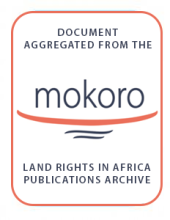Land Library Search
Through our robust search engine, you can search for any item of the over 73,000 highly curated resources in the Land Library.
If you would like to find an overview of what is possible, feel free to peruse the Search Guide.
/ library resources
Showing items 1 through 9 of 251.The paper aims to understand what land rights women have under formal and customary legal systems in pastoral areas in Ethiopia;how these are implemented and what their impact is;and to make recommendations for their convergence.
The restitution of ancestral land rights in Namibia has divided opinions since independence. Some argue it is a fitting process in dealing with colonial era land dispossessions;others are concerned about the complexity of implementing this kind of restitution.
For the past few decades;efforts to strengthen women’s land rights in many sub-Saharan African countries have primarily focused on a single approach: systematic registration through individual/joint certification or titling.
Describes how community-level dialogues uprooted harmful gender norms that hinder women’s rights to land. Showed that shifting harmful gender norms at the community level is crucial in supporting women to access land rights.
Explores what the Prindex 2020 dataset tells us about land rights in sub-Saharan Africa. One in four people in Africa live with the fear of being evicted day-to-day: one of the highest rates in the world.
Informal settlements represent a challenging operational context for local government service providers due to precarious contextual conditions.
Issues relating to land are specifically referred to in five of the United Nations’ (UN) 17 Sustainable Development Goals, and UN-Habitat’s Global Land Tools Network views access to land and tenure security as key to achieving sustainable, inclusive and efficient cities.
Despite Tanzania’s progressive legal framework on land rights and governance;many women are often left out of community decision-making due to social and cultural norms that persist in some areas of the country.
Describes how inclusive technology;a gender-responsive documentation process and shifting gender norms are empowering women through secure land rights. Includes recognising women as landowners;leading by example;securing land;securing futures.


